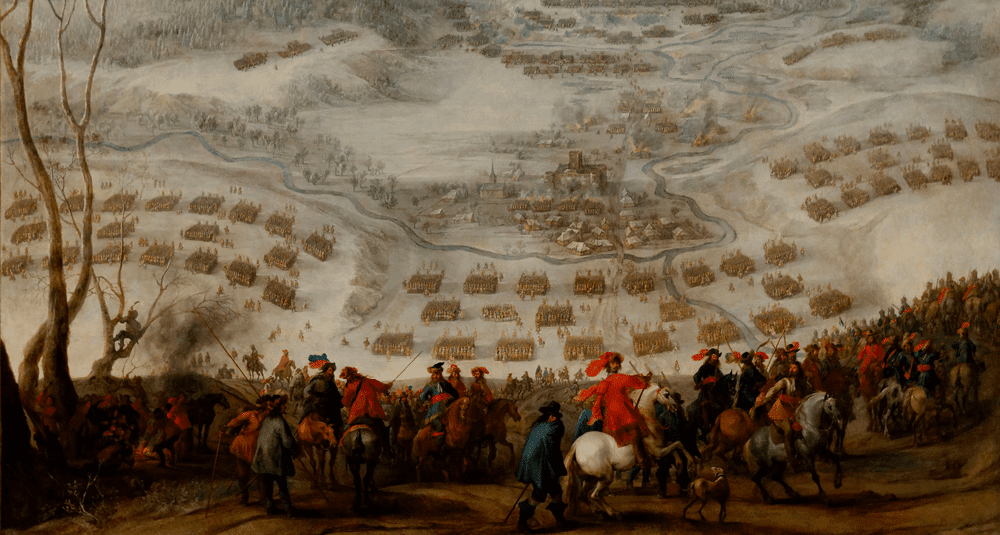What treaties ended the Thirty Years’ War?
Last Updated:
The Thirty Years’ War, which ravaged Europe from 1618 to 1648, ended with a series of historic agreements known as the Treaties of Westphalia. Signed on October 24, 1648 in the German cities of Münster and Osnabrück, these treaties officially put an end to one of the most devastating conflicts in European history, both in terms of its duration and its human, religious and political consequences.
The Thirty Years’ War began in 1618 in the Holy Roman Empire following the defenestration of Prague, an act of defiance by the Protestant nobles of Bohemia against the Catholic imperial power. What started out as a religious war between Catholics and Protestants quickly turned into a European geopolitical war involving major powers such as France, Spain, Sweden and the United Provinces.
The conflict blended denominational rivalries, dynastic ambitions and territorial issues. Germany, fragmented into a multitude of states, became the main battleground. Civilian and military losses were considerable, exacerbated by famine, epidemics and looting.
Faced with an impasse in the conflict, negotiations began in 1644 in Münster and Osnabrück, two cities in the region of Westphalia, chosen because one was Catholic (Münster) and the other Protestant (Osnabrück), in order to facilitate diplomatic exchanges. These long and complex negotiations culminated on October 24, 1648 in a series of legal texts signed by the main powers involved.
The Treaties of Westphalia, signed in 1648, are a set of diplomatic agreements concluded at the end of the Thirty Years’ War. They included the Treaty of Münster between France and the Holy Roman Empire, another Treaty of Münster between Spain and the United Provinces, by which Spain finally recognized the independence of the Netherlands, and the Treaty of Osnabrück, signed between Sweden and the Holy Roman Empire, which guaranteed Sweden several territorial advantages.
These treaties profoundly transformed the political and religious balance of Europe. One of the most important changes was the recognition of the sovereignty of the states of the Holy Roman Empire, giving each prince the right to choose the religion of his territory, be it Catholicism, Lutheranism or Calvinism. This put an end to attempts at religious unification imposed by the Emperor.
At the same time, Habsburg imperial power was considerably weakened. The Emperor’s authority was greatly reduced in favor of the territorial princes, who gained greater autonomy.
France made significant territorial gains, notably in Alsace, consolidating its influence in the east of the kingdom. Sweden, meanwhile, strengthened its position on the Baltic Sea with the acquisition of Western Pomerania and rights to the mouths of the Elbe and Rhine rivers.
Finally, one of the fundamental contributions of the treaties was the official recognition of the independence of the United Provinces and Switzerland, now considered sovereign states. This marks a new stage in the formation of modern nation-states, and lays the foundations for a new European diplomatic order, based on respect for sovereignty and multilateral negotiation.
The Treaties of Westphalia not only put an end to the Thirty Years’ War, they also laid the foundations for a new international order based on state sovereignty. Each state could now decide its own domestic policy, including religious policy, without outside interference.
This concept of the sovereign state marked the beginning of the Westphalian system, still referred to today as the foundation of modern international law. It introduced the practice of multilateral negotiation and diplomatic congresses, a practice that would be repeated in the centuries that followed (Treaty of Utrecht, Congress of Vienna).
The Treaties of Westphalia, signed in 1648 in Münster and Osnabrück, put an end to the Thirty Years’ War, a religious and political conflict of European scope. These agreements redefined the map of Europe and established the fundamental principle of state sovereignty. In this respect, they represent a major turning point in the diplomatic, political and legal history of Europe.
history

What treaties ended the Thirty Years' War?
Answer
The Thirty Years' War ended in 1648 with the Treaties of Westphalia, signed in Münster and Osnabrück, which redefined political Europe.